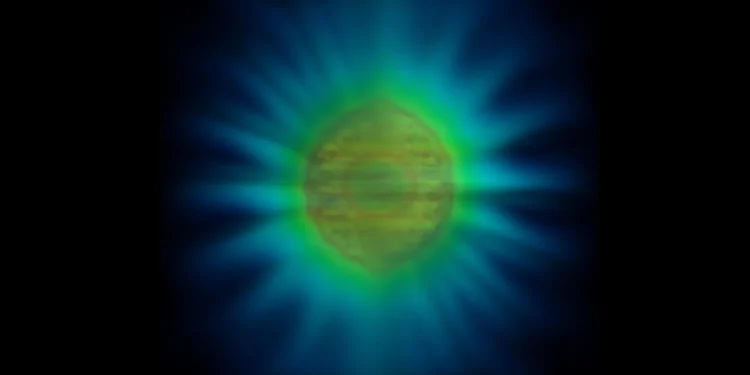
When we look at the world around us, everything we see is due to light. It reflects, refracts and interacts, transmitting the shape and depth of the objects it touches.
But what about the light itself?
Physicists have now visualized the simulated shape of a photon (the smallest unit of light) emitted from the surface of a nanoparticle using a new theoretical model. These discoveries provide new insights into the behavior of light, potentially paving the way for innovations in nanophotonics and quantum technology.
“We were able to produce this image of a photon, something that has never been seen before in physics,” said theoretical physicist Ben Yuen, lead author of the study.
What does a photon look like?
The visualization, created by researchers at the University of Birmingham, is not a photograph; you can’t just photograph a photon. Rather, it is a detailed simulation derived from quantum calculations. “Our calculations allowed us to convert a seemingly intractable problem into something that can be calculated,” Dr. Yuen said. “And, almost as a byproduct of the model, we were able to produce this image of a photon, something that has never been seen before in physics.”
The “shape” of a photon, as physicists define it in this case, is an intensity distribution – a map of where the photon is most likely to be at any given time. Brighter regions indicate areas where the photon is more likely to appear. Dr. Yuen explained in more detail for New Atlas: “As it is a quantum particle, you cannot measure it all at once because the measurement destroys it. However, if you were to repeat the measurement several times, you would see exactly this distribution.”
This achievement required a major step forward in quantum field theory, combining complex analysis and nanoparticle interactions. By simulating a photon emitted by an atom placed on a silicon nanoparticle, the researchers highlighted an important observation: the environment profoundly shapes the photon. The nanoparticle, for example, made the photon thousands of times more likely to be emitted and even allowed it to be reabsorbed by the atom several times.
Why is this important?
By better understanding the fundamental interactions between light and matter, scientists can design advanced technologies. The results could be useful in areas ranging from quantum computing to renewable energy. “By understanding this, we have laid the foundation for designing light-matter interactions for future applications,” Yuen said. “Think better sensors, improved photovoltaic cells, or quantum computing.”
In quantum information systems, for example, the shape of a photon could determine how efficiently it carries data. In biological systems, this could help scientists understand how light triggers chemical reactions like photosynthesis.
Traditionally, scientists model this interaction using simplified equations that view light as moving through empty space or bouncing between mirrors in a cavity. These methods fail, however, when light interacts with complex materials, such as nanoparticles, quantum dots or biological molecules, where the geometry of the environment significantly reshapes the photon itself.
“The geometry and optical properties of the environment have profound consequences for how photons are emitted, including determining the shape, color and even the likelihood that they exist,” said co-author Angela Demetriadou, a professor of theoretical nanophotonics at Birmingham.
This means that a photon does not have a universal form. Each one is sculpted by the environment from which it emerges, its “body” modeled by the surrounding electromagnetic fields. Thus, the “shape” of each photon will be different, depending on the materials with which it interacts.
In this case, Yuen and Demetriadou simulated a photon emitted by a silicon nanoparticle just a micrometer in diameter. The result was an unbalanced lemon-shaped structure – its asymmetry was a direct imprint of how the particle’s surface influenced the quantum fields from which the photon arose.
“That’s really the point of nanophotonics,” Yuen said. “By shaping the environment, we can actually shape the photon itself.”
For a particle as elusive as the photon, this discovery is nothing short of enlightening.
The results were published in the journal Physical Examination Letters.
This article was originally published in November 2024 and has been updated with new information.









